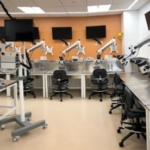Review Prepared by Janette Oliver, Global Outcomes & Rehabilitation Manager, Cochlear Limited, BA., Dip Teach., M.Ed., PG Dip.Ed(Hearing Impaired) Dip.Aud., MA., MAudSA,CCP, Cert AVT
Hearing loss is complex and impacts on every aspect of a person’s life. The aim of aural rehabilitation is to help improve an individual’s quality of life through optimizing hearing function and communication.
To do this in a meaningful way we need to move beyond the assumption that device fitting alone is enough.
This assumption may discourage adult cochlear implant recipients from seeking appropriate aural rehabilitation and is often the reason why passive exposure is commonly recommended to recipients in clinics.
As a result, adult cochlear implant users typically adapt to the implant passively through everyday exposure to routine sounds in order to accurately pair an auditory stimulus to meaning.1
However, while device fitting alone may lead to improved hearing outcomes, a more holistic approach to rehabilitation which also addresses combined perceptual and cognitive skills training, knowledge acquisition and counseling will support broader real-life listening and communication outcomes. 2,3
Holistic care
A holistic approach is also shaped by the requirements of the individual – their needs, abilities, social and physical contexts and preferences.
Several researchers have also argued that hearing loss needs to be managed under a model of care that follows on from the World Health Organisation ICF framework for intervention and treatment of disability.4
This framework not only considers the physical hearing impairment (fitting appropriate technology), but also:
- The impact it has on the individual in terms of activity limitations (such as inability to perceive speech in noisy environments)
- Participation restrictions (such as the ability to fully participate in conversational activities)
- Quality of life (includes such things as enjoyment and independence)5
More recently, Moberly et al (2020) proposed a comprehensive auditory rehabilitation approach along similar lines, incorporating device fitting and management, instruction, counseling and auditory training maximizes the opportunity to optimize speech recognition and quality of life outcomes for adult cochlear implant users.6
The pilot study conducted by this group demonstrated that such an holistic approach is feasible with adult cochlear implant users. A larger-scale trial is recommended by the authors to demonstrate the efficacy of this comprehensive auditory rehabilitation (CAR) approach as compared to current standard-of-care or additional preoperative counselling.
Read more about rehabilitation now!
References:
1. Drouin, J. R., & Theodore, R. M. (2020). Leveraging interdisciplinary perspectives to optimize auditory training for cochlear implant users. Language and Linguistics Compass. https://doi.org/10.1111/lnc3.12394
2. Boothroyd, A (2007). Adult aural rehabilitation: what is it and does it work? Trends Amplif. 2007 Jun;11(2):63-71.
3.Ferguson, M., Maidment, D., Henshaw, H., & Heffernan, E. (2019). Evidence-Based Interventions for Adult Aural Rehabilitation: That Was Then, This Is Now. Seminars in hearing, 40(1), 68–84. https://doi.org/10.1055/s-0038-1676784]
4. McMahon, C, Gopinath, Schneider,J, Reath,J., Hickson,L, Leeder,S., Mitchell, P., Cowan, R. (2013) The Need for Improved Detection and Management of Adult-Onset Hearing Loss in Australia. International Journal of Otolaryngology Volume 2013, Article ID 308509, https://dx.doi.org/10.1155/2013/308509]
5. [https://www.who.int/classifications/international-classification-of-functioning-disability-and-health]
6. Moberly, A. C., Vasil, K., Baxter, J., Klamer, B., Kline, D., & Ray, C. (2020). Comprehensive auditory rehabilitation in adults receiving cochlear implants: A pilot study. Laryngoscope Investigative Otolaryngology. https://doi.org/10.1002/lio2.442.


